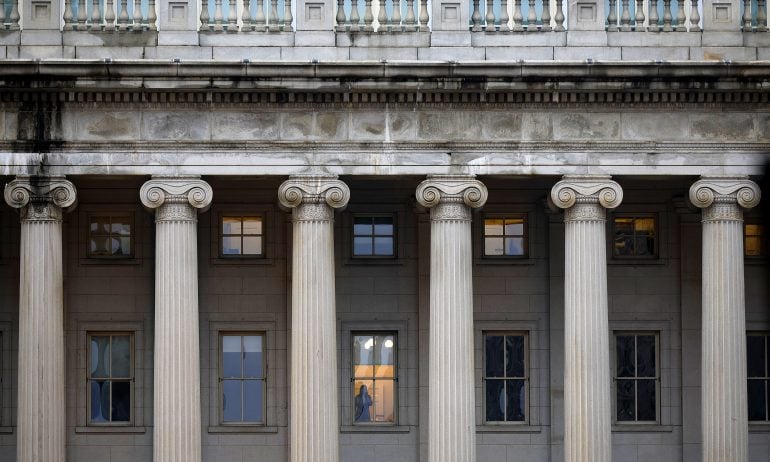Another Impasse: Will the Government Shut Down Oct. 1?

Many or all of the products featured here are from our partners who compensate us. This influences which products we write about and where and how the product appears on a page. However, this does not influence our evaluations. Our opinions are our own. Here is a list of our partners and here's how we make money.
Updated on Sept. 18. The original story, focused on the earlier debt ceiling standoff, was published on May 1.
Latest news: On Sept. 17, House Republicans proposed a short-term spending bill — known as a continuing resolution — that would fund the government through Oct. 31. It includes an 8% cut to domestic spending. Even if the bill passes the House, it is highly likely the Democrat-led Senate will reject the proposal.
The U.S. faces government shutdown on Oct. 1 if Congress does not enact a new spending package or a stopgap. A shutdown could disrupt many federal government operations, which would have impacts on federal workers, the U.S. economy and everyday Americans. There’s little time left for Congress to act to avert a shutdown: The Senate reconvened on Sept. 5 after summer recess while the House returned on Sept. 12.
A shutdown is different than default, the scenario the U.S. narrowly averted just months ago.
Here’s why a shutdown might happen and what’s at stake.
Possible government shutdown: How we got here
Federal agencies are legally required to have approved appropriations from Congress in order to spend money.
Congress has 12 appropriation bills to approve in order to fund 12 major federal agencies before the 2024 fiscal year begins on Oct. 1.
The debt ceiling deal — known as the Fiscal Responsibility Act — signed in June included a discretionary spending cap of $1.59 trillion for two years. While the Senate has passed appropriation bills in line with the agreement, House Republicans want the spending level down to the 2022 budget, and are also including provisions on social issues such as abortion that are not likely to pass the Democrat-led Senate. (There’s more information on the debt ceiling deal below.)
The White House is also asking for $44 billion in additional emergency funding for things like aid to Ukraine, the Federal Emergency Management Agency (FEMA) and border security.
Congress is divided and the funding bills are likely to be, as well. When each chamber passes different bills, the two must compromise in a conference committee before a spending bill can be sent to the president to sign.
If a deal isn’t reached, Congress could pass a stopgap — known as a “continuing resolution” — that would temporarily extend current budget levels to keep the government functioning. However, it’s unlikely a continuing resolution will remain in effect after this year. That’s because the Fiscal Responsibility Act includes a provision that says if a continuing resolution is in effect come Jan. 1, then the spending limit revises on its own, according to the Brookings Institution. That automatic revision includes a significant cut to defense, which would be at direct odds with House Republicans’ moves this year to increase defense spending.

What is a government shutdown?
When the government shuts down, many federal agencies must suspend all non-essential services. Each federal agency must develop its own contingency plan for shutdowns, which includes employee furloughs and service reductions.
Non-essential services that would be suspended likely include national parks, the Internal Revenue Service’s customer service and Federal Student Aid assistance (although you can still apply for aid — and those student loan bills are still due beginning in October).
Any programs that receive mandatory funding will continue operations. That includes essential services, such as air traffic control, law enforcement, power grid maintenance, in-hospital medical care and border protection, according to the Center for a Responsible Federal Budget.
Other mandatory spending that doesn’t require annual appropriations will continue, but service may be reduced including:
Social Security, Medicare and Medicaid. Checks will continue, but benefit verifications may be suspended.
Supplemental Nutrition Assistance Program funding is mandatory, but benefits may stop altogether after 30 days of a shutdown.
Food and environmental inspections through the Food and Drug Administration and the Environmental Protection Agency would likely be halted or reduced.
The Centers for Disease Control and Prevention as well as the National Institutes of Health could also see reduced operations — not ideal during a covid surge.
When was the last government shutdown?
There have been 21 government shutdowns since 1976. The most recent government shutdown was also the longest yet, beginning on Dec. 22, 2018 and lasting until Jan. 25, 2019 — a total of 34 full days. However, most past shutdowns lasted less than a week.
Government shutdowns are costly in more ways than one: The 2018 to 2019 partial shutdown cost $18 billion in federal discretionary spending and reduced Gross Domestic Product (GDP) by $11 billion, according to the Congressional Budget Office.
When Congress passes some but not all of the required appropriations, the result is a partial shutdown.
The government almost ran out of money this year
The latest threat of government shutdown comes mere months after the federal government had a different kind of funding crisis with more disastrous implications. The U.S. hit its debt ceiling in January and narrowly avoided a default in June that would have triggered a financial crisis. Here’s how it went down:
The United States hit its $31.381 trillion debt ceiling, or limit, on Jan. 19. Once that debt limit was reached, the federal government became at risk of default.
The Treasury Department began to implement “extraordinary measures” shortly thereafter so the government could continue to meet its legal obligations — already approved by Congress — to fund things like Social Security, Medicare, tax refunds and military salaries. Those extraordinary measures included suspending payments on retirement and health care funds for government employees.
On May 1, the Treasury Department made further measures to fund the government until the X-date — June 1 — when it was projected to run out of money. Those measures included suspending the issuance of State and Local Government Series Treasury securities, which are issued to states and municipalities to help them comply with certain tax rules. These securities count against the debt limit.
After months of tense negotiations, President Joe Biden and House Speaker Kevin McCarthy reached an agreement: the “Fiscal Responsibility Act of 2023,” signed by Biden on June 3. Learn more about what was in the deal.
What could have happened if the U.S. defaulted?
Defaulting would have been very bad at best and catastrophic at worst. The U.S. has defaulted only once, and it was due to a technical glitch in 1979. But it has also come close before: In 2011, negotiations dragged on so long the S&P downgraded the U.S. credit rating, which contributed to volatility in the markets.
A default that lasts longer than a few days could have resulted in a financial crisis that reverberates around the world. It could have included a sell-off of U.S. debt; money market funds selling out; suspension of federal benefits; increased interest rates on lending products and mortgages; tanking stock markets; delayed tax refunds; and the gross domestic product, or GDP, plummeting. A default would have also increased higher interest rates, tightened credit requirements and accelerated the arrival of a recession.
How do you solve a problem like the debt ceiling?
The most recent threat of default won’t be the last. So how can an eleventh-hour deal be avoided in the future? The clearest route to avoid future defaults is if Congress agrees to raise the debt ceiling before the government hits its so-called X-date — the date on which the federal government would go into default. But other options have been raised.
It’s unclear whether the president would have the executive power to lift the debt ceiling without congressional approval. It also raises the question of the legality of such an action.
Other ideas that have been floated range from “sober finance” to “tin-hat silliness,” says William Gale, senior fellow in the economic studies program at the Brookings Institution, a nonprofit research organization focused on public policy. Those ideas include:
• Minting the trillion dollar coin. A once-fringe, now-mainstream strategy to bypass the debt limit by having the Treasury mint a trillion-dollar platinum coin and deposit it into the Federal Reserve. Gale says he has no idea whether the Fed would accept this option or the legality of it.
• The Treasury issues consol bonds to meet debt obligations. These bonds, also called perpetuity bonds, pay out interest and have no maturity date. The lack of a maturity date means these bonds wouldn’t count under the debt ceiling.
“The Treasury can say, 'Here's a piece of paper. If you give us a dollar, we'll give you whatever the Treasury interest rate is, forever.' So every year you get a payment,” Gale says. “But the thing never pays off. It’s not a 10-year Treasury or a 30-year Treasury. It's infinite, so it wouldn't count under the debt ceiling.”
• The Fed returns Treasury debt back to the Treasury. The majority of federal debt is made up of Treasury securities. At its peak in early 2022, the Fed held $6.25 trillion in federal debt. By the close of the year, it was around $5.9 trillion.
There are other potentially serious, potentially gimmicky options in addition to the ones above, but the most feasible option is always the simplest: Congress acts, and the president signs.
Photo by Chip Somodevilla/Getty Images via Getty Images

